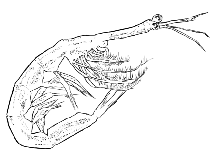Lucifer chacei Bowman, 1967
| Native range | All suitable habitat | Point map | Year 2050 |

|
| This map was computer-generated and has not yet been reviewed. |
| Lucifer chacei AquaMaps Data sources: GBIF OBIS |
Classification / Names Common names | Synonyms | CoL | ITIS | WoRMS
Malacostraca | Decapoda | Luciferidae
Environment: milieu / climate zone / depth range / distribution range Ecology
Pelagic; depth range 10 - 100 m (Ref. 96667). Tropical; 33°N - 33°S, 27°E - 135°W
Distribution Countries | FAO areas | Ecosystems | Occurrences | Introductions
Indo-Pacific: Eastern Africa to Hawaii and Tahiti. Tropical and subtropical.
Length at first maturity / Size / Weight / Age
Maturity: Lm ? range ? - ? cm
Short description Morphology
Last segment of peduncle of ant. 2 in male reaches beyond eye and nearly distal margin of 1st segment of ant. 1 peduncle, in female reaches beyond middle of cornea and to distal third of 1st segment of ant. 1 peduncle; rostrum reaches proximal border of statocyst; ventral cushion of male telson much broader than its posterior height; sheath of petasma curved.
Life cycle and mating behavior Maturity | Reproduction | Spawning | Eggs | Fecundity | Larvae
Growth from eggs to adults (7-8 mm) takes more or less 3 weeks (Ref. 97303). After fertilization, eggs remain attached to the females by short stalks to the ischia of the third pereopods until hatching (Ref. 78954).
Main reference
References | Coordinator | Collaborators
Pérez Farfante, I. and B. Kensley. 1997. (Ref. 75620)
IUCN Red List Status (Ref. 130435: Version 2024-1)
CITES status (Ref. 108899)
Not Evaluated
CMS (Ref. 116361)
Not Evaluated
Threat to humans
Human uses
| FishSource |
Tools
More information
Trophic Ecology
Ecology
Population dynamics
Growth
Age/Size
Length-weight
Length-length
Length-frequencies
Mass conversion
Recruitment
Abundance
Age/Size
Length-weight
Length-length
Length-frequencies
Mass conversion
Recruitment
Abundance
Life cycle
Distribution
Human Related
Aquaculture profile
Stamps, Coins Misc.
Stamps, Coins Misc.
Outreach
References
Internet sources
BHL | BOLD Systems | CISTI | DiscoverLife | FAO(Publication : search) | Fishipedia | GenBank (genome, nucleotide) | GloBI | Gomexsi | Google Books | Google Scholar | Google | PubMed | Tree of Life | Wikipedia (Go, Search) | Zoological Record
Estimates based on models
Preferred temperature
(Ref. 115969): 25 - 29, mean 28 (based on 1502 cells).
Price category
(Ref. 80766):
Unknown.



